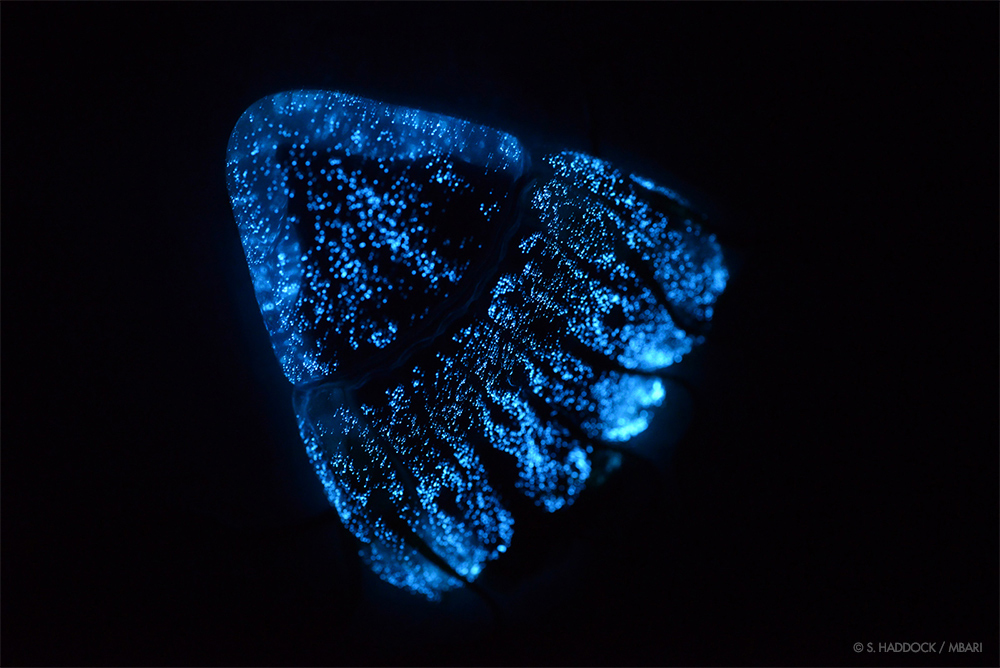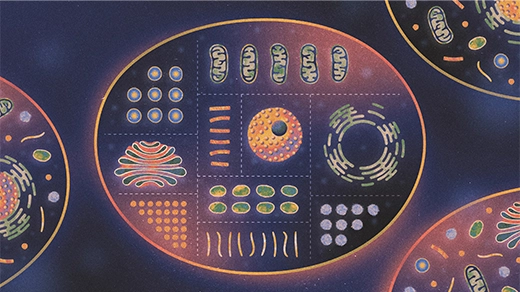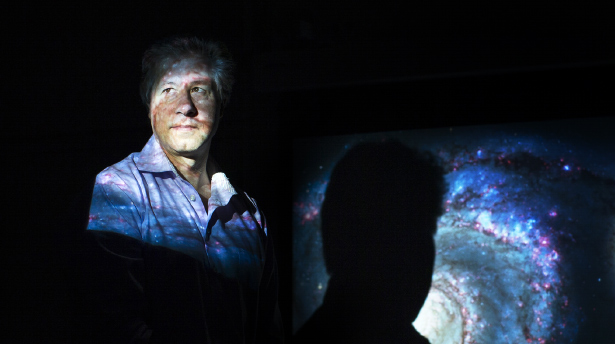In the Deep, Clues to How Life Makes Light

Dive deep enough under the surface of the ocean, and light reigns. Some 90 percent of the fish and crustaceans that dwell at depths of 100 to 1,000 meters are capable of making their own light. Flashlight fish hunt and communicate with a flashing Morse code sent by light pockets that pulse under their eyes. Tubeshoulder fish shoot luminous ink at their attackers. Hatchetfish make themselves appear invisible by generating light on their underbellies to mimic downwelling sunlight; predators prowling below look up to see only a continuous glow.
Scientists have indexed thousands of bioluminescent organisms across the tree of life, and they expect to add many more. Yet researchers have long wondered how bioluminescence came to be. Now, as explained in several recently released studies, researchers have made significant progress in understanding the origins of bioluminescence — both evolutionary and chemical. The new understanding may one day allow bioluminescence to be used as a tool in biology and medical research.
One longstanding challenge has been determining how many separate times bioluminescence arose. How many species came to the same conclusion, independent of one another?
Though some of the most familiar examples of light from living organisms are terrestrial — think of fireflies, glowworms and foxfire — the bulk of evolutionary events involving bioluminescence took place in the ocean. Bioluminescence is in fact markedly absent from all terrestrial vertebrates and flowering plants.
In the deep ocean, light gives organisms a unique way to attract prey, communicate and defend themselves, said Matthew Davis, a biologist at St. Cloud State University in Minnesota. In a study released in June, he and his colleagues found that fish that use light for communication and courtship signaling were especially diverse. Over a period of about 150 million years — brief by evolutionary standards —such fish proliferated into more species than other groups of fish. Bioluminescent species that used their light exclusively for camouflage, on the other hand, were no more diverse.
Courtship signals can change relatively easily. These changes can in turn create subgroups in a population, which eventually split into unique species. In June, Todd Oakley, an evolutionary biologist at the University of California, Santa Barbara, and one of his students, Emily Ellis, published a study in which they found that organisms that use bioluminescence in courtship had significantly more species, and faster rates of species accumulation, than closely related organisms that do not use light. Oakley and Ellis studied ten groups of organisms, including fireflies, octopuses, sharks and tiny crustaceans called ostracods.
The study by Davis and his colleagues was limited to ray-finned fishes, a group that includes approximately 95 percent of fish species. Davis estimated that even in that single group, bioluminescence evolved at least 27 times. Steven Haddock, a marine biologist at the Monterey Bay Aquarium Research Institute and an expert on bioluminescence, estimated that across all life forms bioluminescence evolved independently at least 50 times.
Many Ways to Glow
In nearly all shining organisms, bioluminescence requires three ingredients: oxygen, a light-emitting pigment called a luciferin (from the Latin word lucifer, meaning light-bringing), and an enzyme called a luciferase. When a luciferin reacts with oxygen — a process facilitated by luciferase — it forms an excited, unstable compound that emits light when it returns to its lowest energy state.
Curiously, there are far fewer luciferins than luciferases. While species tend to have unique luciferases, many share the same luciferin. Just four luciferins are responsible for most of the light production in the ocean. Of close to 20 groups of bioluminescent organisms in the world, a luciferin called coelenterazine is the light-emitter in nine.
Yet it would be a mistake to assume that all coelenterazine-containing organisms had evolved from a single luminous ancestor. If they had, asked Warren Francis, a biologist at Ludwig Maximilian University in Munich, then why did they develop such a wide variety of luciferases? Presumably the first luciferin-luciferase pair would have survived and multiplied.
It’s more likely that many of these species don’t make coelenterazine themselves. Instead, they get it from their diet, said Yuichi Oba, a professor of biology at Chubu University in Japan.
In 2009, a group led by Oba discovered that the deep-sea copepod — a tiny, near-ubiquitous crustacean — makes its own coelenterazine. These copepods are an extremely abundant food source for a wide range of marine animals — so much so that “in Japan, we call copepods ‘rice in the ocean,’” Oba said. He thinks copepods are key to understanding why so many marine organisms are bioluminescent.
Oba and his colleagues took amino acids believed to be the building blocks of coelenterazine, labeled them with a molecular marker, and loaded them into copepod food. They then fed this food to copepods in the lab.
After 24 hours, the researchers extracted coelenterazine from the copepods and looked for the labels they had added. Sure enough, the labels were there — definitive proof that the crustaceans had synthesized luciferin molecules from the amino acids.
Even the jellyfish in which coelenterazine was first discovered (and named after) was later found not to produce its own coelenterazine at all. It obtains its luciferin by eating copepods and other small crustaceans.
Mysterious Origins
Researchers have found another clue that might help explain the popularity of coelenterazine in deep-sea animals: the molecule also exists in organisms that don’t emit light. This struck Jean-François Rees, a biologist at the Catholic University of Louvain, in Belgium, as odd. It’s already surprising “that so many different animals rely on exactly the same molecule for producing light,” he said. Perhaps coelenterazine had another function besides luminescence?
In experiments with rat liver cells, Rees showed that coelenterazine is a powerful antioxidant. His hypothesis: perhaps coelenterazine first proliferated in marine organisms living in surface waters. There, an antioxidant would have provided much-needed protection against oxidative stress from harmful sun rays and high rates of respiration.
When these organisms began colonizing deeper layers of the ocean, where the need for antioxidants is lower, coelenterazine’s ability to emit light became useful, Rees theorized. Over time, organisms evolved different strategies — like luciferases and specialized light organs — to enhance this property.
Still, researchers have not discovered how organisms other than Oba’s copepods make coelenterazine. The genes that encode for coelenterazine are also completely unknown.
Enter the comb jelly. These ancient sea creatures — thought by some to be the first branch off the animal family tree — have long been suspected of being able to produce coelenterazine. But no one had been able to confirm that, much less track the genetic instruction kit at work.
In work reported last year, however, a team of researchers led by Francis and Haddock homed in on a gene that might be involved in synthesizing the luciferin. To do this, they looked at comb jelly transcriptomes, which provide a snapshot of the genes an animal is expressing at any given time. They were searching for genes that encoded for a group of three amino acids — the same amino acids Oba fed to his copepods.
Across 22 species of bioluminescent comb jellies, the scientists found a group of genes that fit their criteria. Those same genes were absent in two other non-luminous species of comb jellies.
“It’s very strong, but still circumstantial, evidence” that these genes might be involved in the production of coelenterazine, Haddock said. As techniques for working with comb jellies in the lab become more advanced, he thinks it may soon be possible to test his team’s findings with gene-manipulation experiments.
The New Flashlight
The genetic machinery of bioluminescence has applications beyond evolutionary biology. If scientists can isolate genes for a luciferin and luciferase pair, they can potentially engineer organisms and cells to glow, for various reasons.
In 1986, scientists at the University of California, San Diego, modified and inserted the firefly luciferase gene into a tobacco plant. The study was published in the journal Science with an image of one of these plants glowing eerily against a dark background.
The plant didn’t create light on its own, however — it contained luciferase, but needed to be watered with a solution containing luciferin to glow.
Thirty years later, scientists are still unable to genetically engineer self-luminous organisms because they don’t know the biosynthetic pathways for most luciferins. (The one exception is in bacteria: researchers have identified the “lux” genes that encode for the bacterial luciferin-luciferase system, but these genes need to be modified to be useful in any non-bacterial organism.)
One of the biggest potential uses for luciferin and luciferase is in cellular biology research — inserting them would be akin to installing lights in cells and tissues. “This type of technology can be used to track anything from where a cell is, to gene expression, to protein production,” said Jennifer Prescher, a professor of chemistry at the University of California, Irvine.
Uses for bioluminescence molecules would be similar to those of the green fluorescent protein, which has been used to follow the fate of HIV infections, visualize tumors and track nerve-cell damage in Alzheimer’s disease.
Currently, researchers who use luciferin for imaging experiments must create a synthetic version or purchase it at $50 per milligram. Delivering externally produced luciferins into cells can also be somewhat challenging — a problem that wouldn’t exist if cells could be engineered to make their own luciferin.
While recent studies are narrowing in on the evolutionary and chemical processes of how organisms produce light, so much of the bioluminescent world still remains in the dark.
This article was reprinted on Wired.com.



